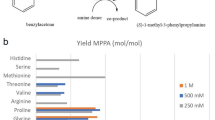Abstract
PREVIOUSLY1 we reported the reduction reaction of α-aminoadipic acid by a yeast enzyme(s) which will now be referred to tentatively as α-aminoadipic acid reductase. The reaction by which α-aminoadipic acid is converted to the corresponding δ-semialdehyde requires the participation of adenosine triphosphate, reduced triphosphopyridine nucleotide and Mg++, and the enzyme is activated by glutathione. The present communication reports the formation of δ-adenyl-α-aminoadipic acid by the α-aminoadipisc acid reductase, together with a possible mechanism of α-aminoadipic acid reduction reaction.
This is a preview of subscription content, access via your institution
Access options
Subscribe to this journal
Receive 51 print issues and online access
$199.00 per year
only $3.90 per issue
Buy this article
- Purchase on SpringerLink
- Instant access to full article PDF
Prices may be subject to local taxes which are calculated during checkout
Similar content being viewed by others
References
Sagisaka, S., and Shimura, K., Nature, 184, 1709 (1959).
Kornberg, A., and Pricer, jun., W. E., J. Biol. Chem., 189, 123 (1951).
Hoagland, M. B., Biochim. Biophys. Acta, 16, 288 (1955).
Craine, R. K., and Lipmann, F., J. Biol. Chem., 201, 235 (1953).
Author information
Authors and Affiliations
Rights and permissions
About this article
Cite this article
SAGISAKA, S., SHIMURA, K. Mechanism of Activation and Reduction of α-Aminoadipic Acid by Yeast Enzyme. Nature 188, 1189–1190 (1960). https://doi.org/10.1038/1881189a0
Issue date:
DOI: https://doi.org/10.1038/1881189a0
This article is cited by
-
Cloning and biochemical characterization of LYS5 gene of Saccharomyces cerevisiae
Current Genetics (1988)
-
Induction and complementation of lysine auxotrophs in Saccharomyces
Antonie van Leeuwenhoek (1974)
-
Relationship among the genes, enzymes, and intermediates of the biosynthetic pathway of lysine in Saccharomyces
Molecular and General Genetics MGG (1972)



